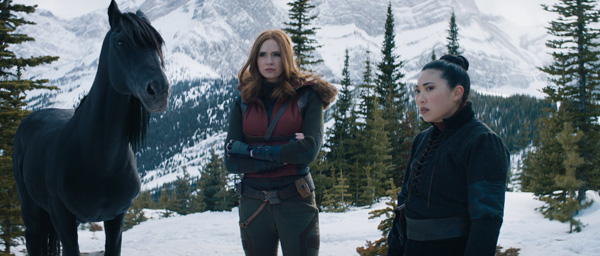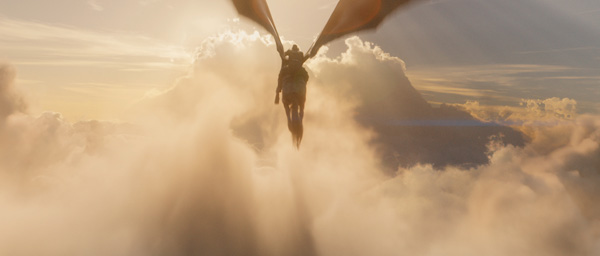
The crew from Jumanji are back in the game, but in ‘Jumanji: The Next Level’, nothing is quite the same as before. As they return to rescue one of their players, they discover that their avatars have changed, the terrain is unknown and unexplored, and the game has turned dangerous.
For the film’s final showdown, Method Studios was chosen to transform the bluescreen sets into complex environments that include a snowbound fortress, a massive blimp and a flying horse, working with production VFX Supervisor Mark Breakspear and director Jake Kasdan. The artists then integrated the actors into the scene as the action accelerates.
Method Studios VFX Supervisor Glenn Melenhorst was on set during production of the sequence in Atlanta. Practical set pieces were minimal, requiring Glenn and his team to build out the fortress, blimp and high, rocky terrain digitally. Starting with the concept art, Method’s artists elaborated on the initial designs bearing in mind the production’s request that the artists keep the fortress and blimp assets grounded in reality to help immerse the audience in the story.
Kit Bashing
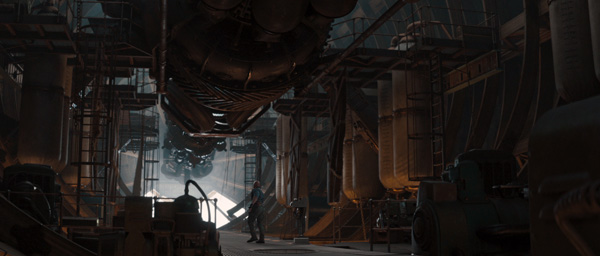
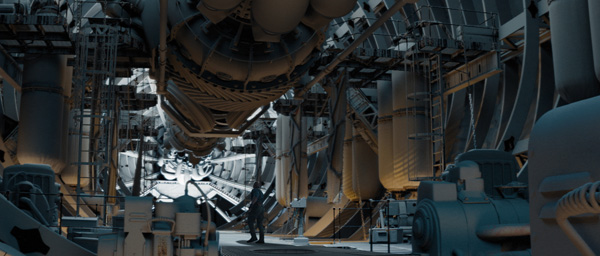
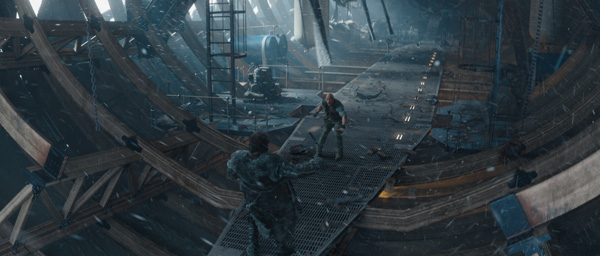
When developing looks for the fortress and blimp, an important theme was the idea of kit bashing, building up the assets from random parts and machinery, from random eras. Glenn said, “For the fortress, we looked at WW2-era concrete bunkers and brutalist postmodern architecture as reference. We wanted it to have old foundations with a suggestion that the evil conqueror, Jurgen the Brutal, had added the concrete additions later on.”
For the blimp, some especially interesting concept art was supplied to the team. Building upon that, the design ended up evolving over time, ultimately becoming the wooden and steel interior seen in the film. The exterior, like the fortress, had to have that same random, kit bashed look. They had tank parts and airplane parts all chained together, hanging from the envelope.
The high number of blimp assets, with the many materials, textures and more, had to be managed efficiently enough to control them in all shots. “We work with a USD pipeline and all of our work is published along our pipeline using BOSS, a proprietary toolset developed in house,” said Glenn. “Having said that, shows like this are pretty demanding of the pipeline because almost every shot had its own unique requirements.

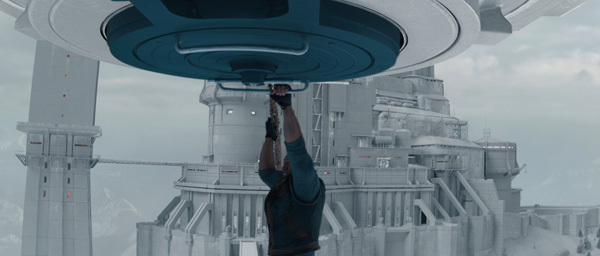
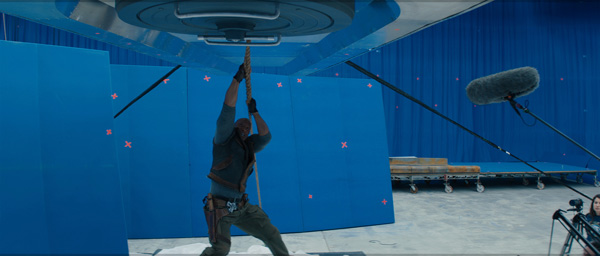
“We always knew the finished shots would be dynamic so keeping the sets minimal was actually an advantage for us. For instance, the blimp had swinging cloth and chains and working engines, as well as a rippling envelope that needed to be ripped as the characters fought. So, we limited the set to the metal floor that the talent were standing on. While on set I requested that the props like the practical chain link railings, boxes and machinery be removed as well, allowing us to deal with them more easily as dynamic CG objects in post.”
Nevertheless, as the story unfolds in a vast environment among massive assets, in the middle of a heavy snow storm, expressing the right sense of scale and depth was an essential, challenging part of communicating the danger the characters are in, and adding excitement.
Scale and Distance
Glenn said, “Having the right camera work is super important for conveying scale in a CG world, and that generally means no cosmic zooms and vast, sweeping moves. As a result, we worked to make our coverage of the environment as realistic as possible, suggesting ideas to the filmmakers that would give us the optimal starting point in the plates to achieve what they were after.
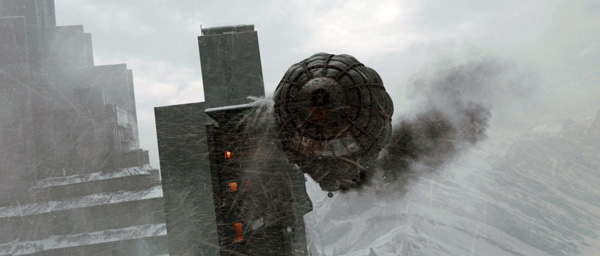
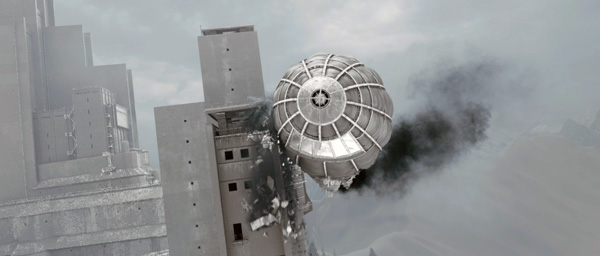
“On top of that, we spent a lot of time on the look of the fortress and the surrounding landscape, adding detail that would make the set feel like a plausible environment. We played a lot with haze, too. A storm of that magnitude would obliterate the distant mountains so we balanced every shot, adjusting both the distant haze and levels of snow to make sure we saw the environment.”
Creating digital shots looking down from the blimp to the fortress, and up from the fortress to the blimp, highlighted the need to keep all elements in scale relative to each other, and convey distance at the same time. “Atmosphere is great for selling scale, as was making sure the blimp was always travelling at the right speed,” he said.
“We also used 3D snow to sell parallax and distance in the shots. There wasn’t much to the storm in terms of tracking its scale. It basically had to grow over the sequence and then stop once the jewel was rescued. Most of the work lay in balancing the amount of snow from shot to shot so it felt consistent. For instance, a tight shot on Ruby would have less snow in front of the lens than a wide shot of the blimp.”
Collision Course
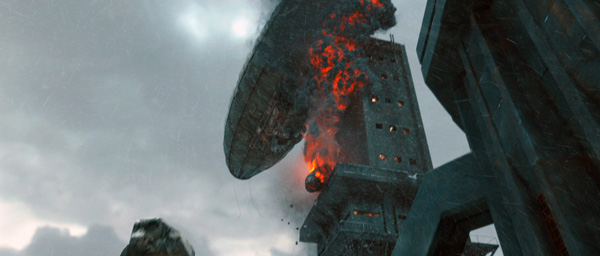
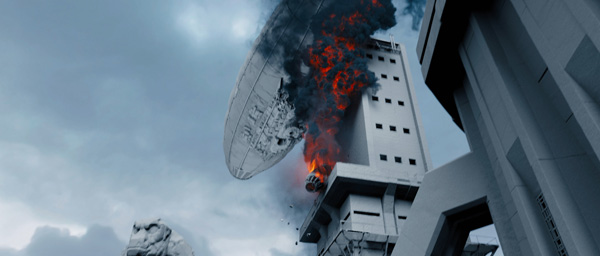
Method also created dynamic FX for the sequence. “The fight inside the blimp is a really cool bit of action,” said Glenn. “The blimp is out of control and ripping apart, with sides flapping, as the characters grapple with each other. We ended up creating nearly everything except the actors in CG and all the pieces came together exactly as we imagined. Everything looks as if it belongs in the scene.”
While they had the blimp looking formidable and just as the client wanted, their building technique also contributed to its destruction later during the collisions and explosions. “Building it in assets meant we could promote the fabric envelope to the cloth team for simulation and the wooden spars to our FX TDs to break apart in Houdini,” he said. “Then we also ‘set dressed’ the snapped wood in assets, building splintered stubs and broken pieces of machinery to support the simulation.
The blimp colliding with the fortress, and especially with the mountain, needed to look impressive and also be viewed from several angles. As always with movies, Glenn commented, there is give and take to make the shots awesome. He explained that sometimes in those collisions, the blimp travels much faster than it should, or takes four or five shots to rip and explode through editing double cuts – that is, showing the same destruction twice from different angles.
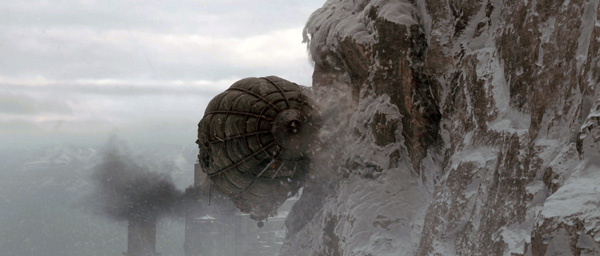
He said, “We tried to bring a sense of believability and scale to the shots by putting our effort into making the explosions convincing and large enough, as well as sending massive shock waves through the fabric envelope of the airship and dislodging snow from the mountainside. We also aimed to use real physics as far as possible to create the damage to all materials, particularly for the interior tearing during the collisions and the ongoing FX afterwards when the fabric is flapping around and snow is blowing inside the airship.”
Taking Flight
During the battle, a new character in the Jumanji story called Ming takes flight on a horse that grows bat-like wings. Glenn and the artists looked at different ways to believably depict the motion of the horse’s legs while in flight. As a result, because the scene was captured while Ming rode a mechanical buck against bluescreen, her in-flight riding motion needed adjusting to align with the horse’s animation, for which Method rebuilt her arms and legs in CG.
Glenn described their anatomical work for the shots. “The animation for bat wings is largely the same as for feathery wings, though we did add in controls to billow and flutter the membrane along them,” he said. “The filmmakers were keen to not see too many angles on the wings, wanting them to be leathery but not too bat like.
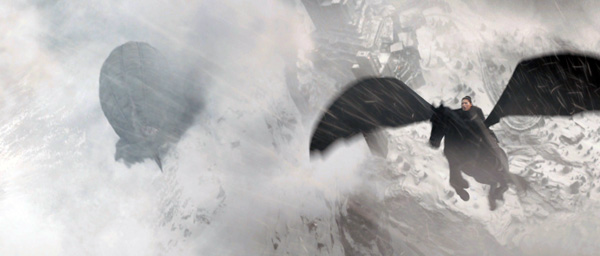
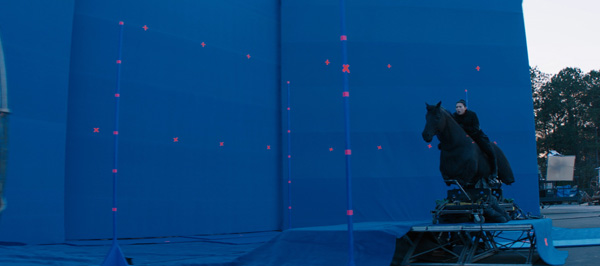
“We added control to curve the bones dynamically, allowing the animators to sculpt more pleasing, rounded shapes when designing the silhouettes for each shot. The legs took a bit of work. We tried to make it look as though the horse was digging for height with his legs, using them less when coasting and barely at all when gliding. That seemed to be the sweet spot.”
When the clouds and light rays surrounding Ming and the horse turn bright and ethereal, Method created a cloudscape viewed from above using Terragen, which simulates light scattering within clouds, and then painted into them here and there. Glenn said, “We animated the clouds’ phasing – taking cloud particles from liquid to solid, icy states – in Terragen as well, and also produced spherical plates to support some of the tighter shots of Ming and Milo [the horse]. For the closer, dynamic clouds, we generated VDBs in Houdini and lit them to complement the clouds generated from Terragen.” www.methodstudios.com
Words: Adriene Hurst
Images: Sony Pictures Entertainment
